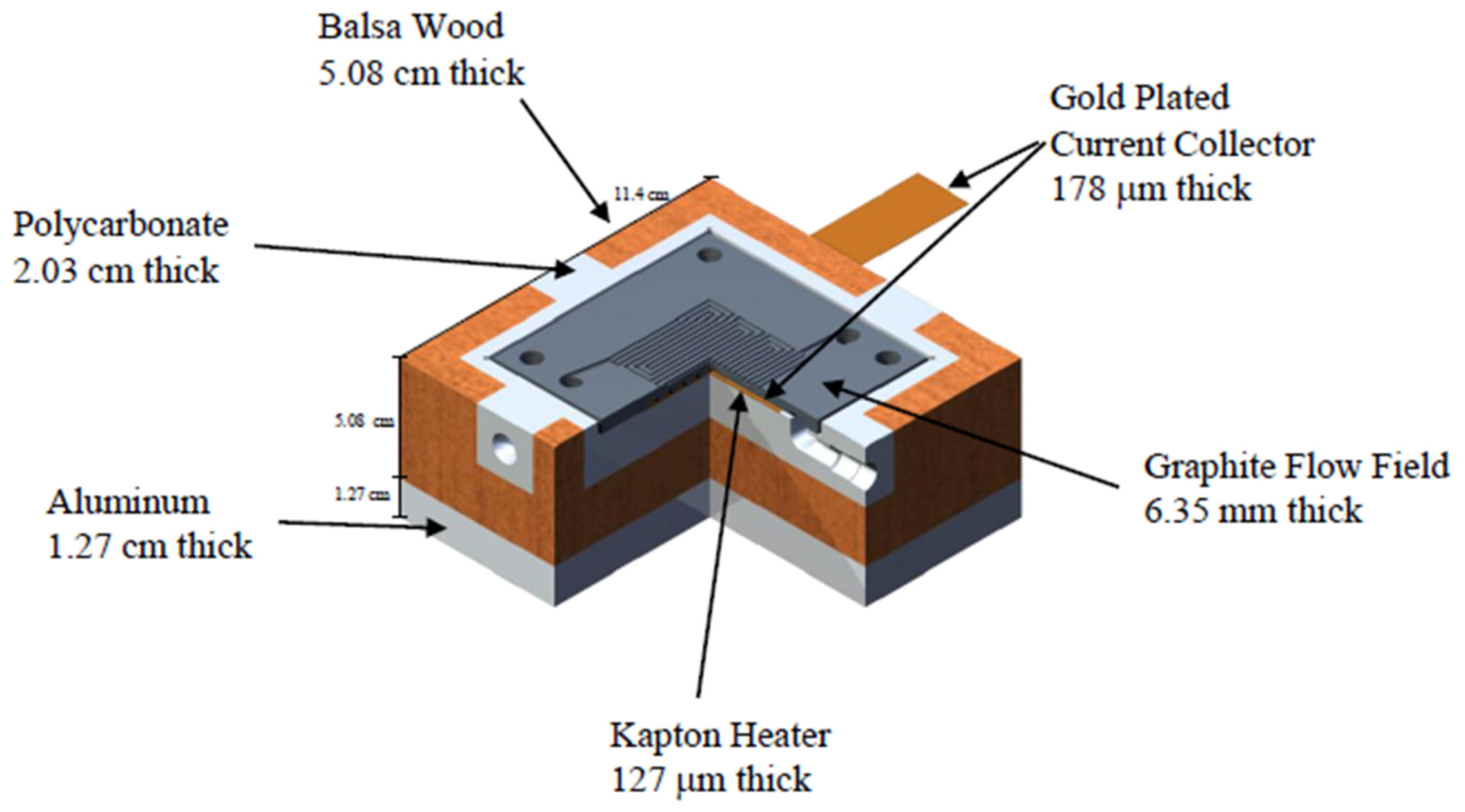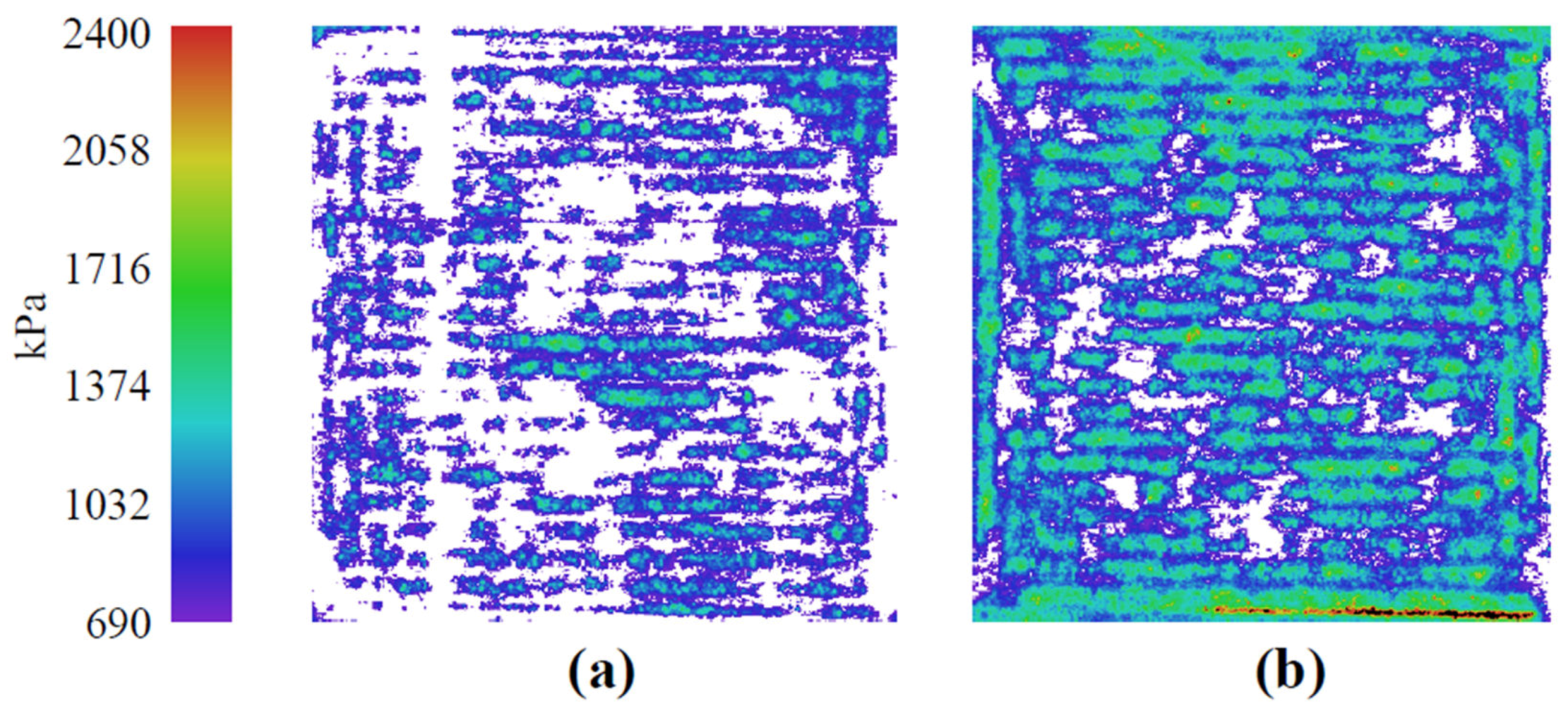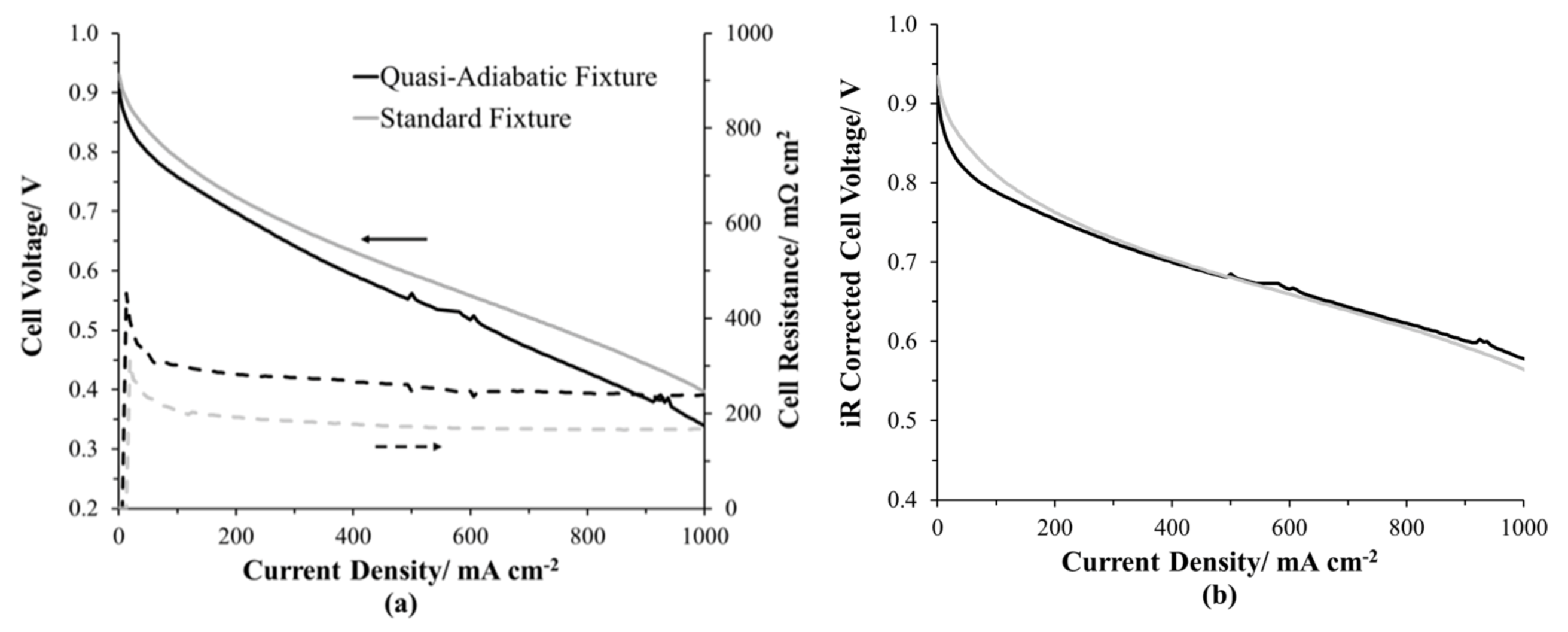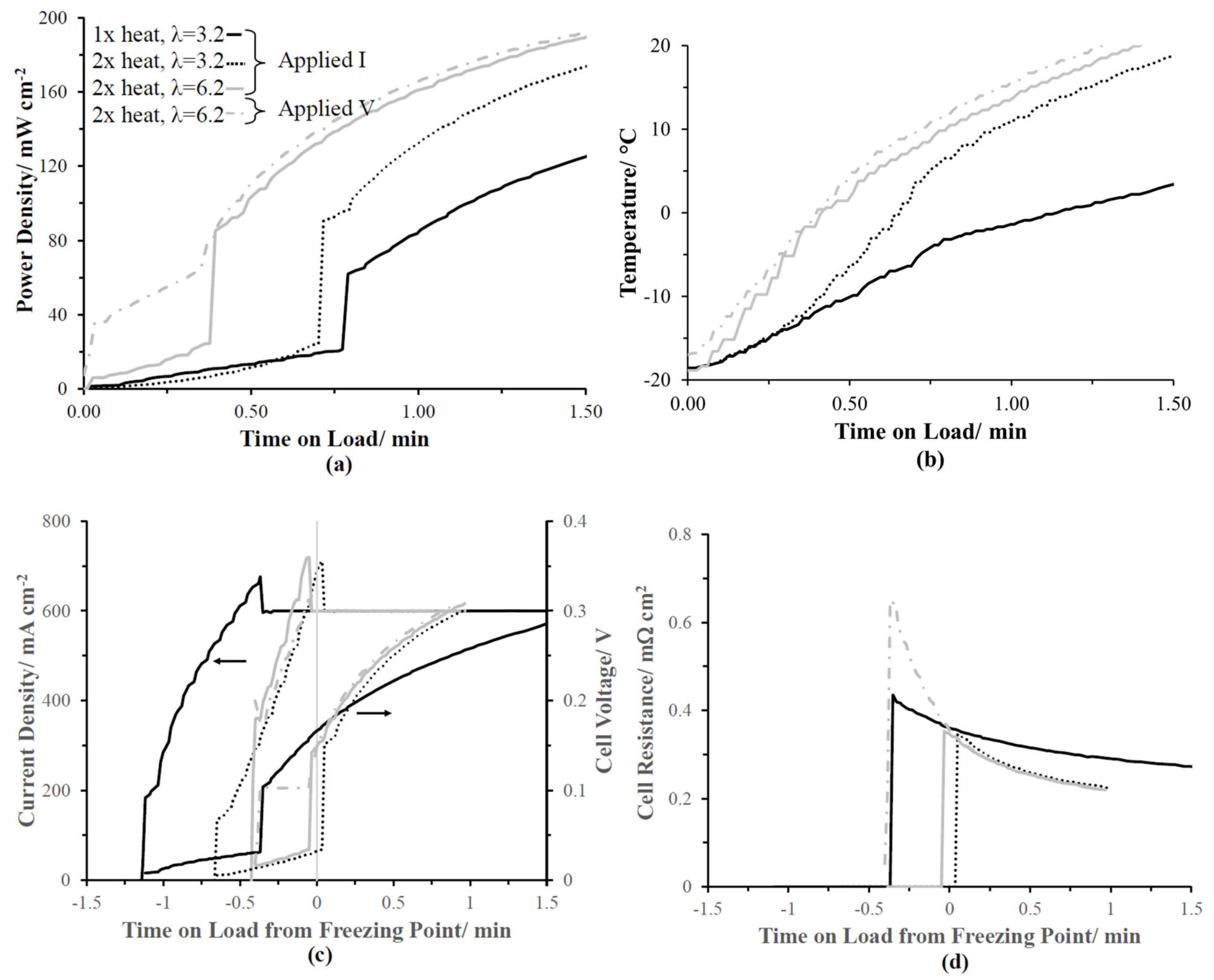Automotive Subzero Cold-Start Quasi-Adiabatic Proton Exchange Membrane Fuel Cell Fixture: Design and Validation
Abstract
1. Introduction
2. Results and Discussion
2.1. Quasi-Adiabatic PEMFC Fixture Design
2.1.1. Humidified Gas Manifolds
2.1.2. Insulation
2.1.3. Uniformity of Applied Axial Load
2.2. PEMFC Testing
2.2.1. Operating Performance
2.2.2. Water Fill Tests
2.2.3. Cold-Starts
2.2.4. Heat Adjustment Factor
2.2.5. Initial Water Content
2.2.6. Applied Load
3. Materials and Methods
3.1. PEMFC Assembly
3.2. Instrumentation
3.3. Materials Characterization
3.4. PEMFC BOL Conditioning
3.5. Freeze Pre-Conditioning
3.6. Water Fill Tests
3.7. Cold-Starts
4. Conclusions
Author Contributions
Funding
Acknowledgments
Conflicts of Interest
References
- Papageorgopoulos, D. Fuel Cells R&D Overview—2018 Annual Merit Review and Peer Evaluation Meeting. Available online: https://www.hydrogen.energy.gov/pdfs/review18/fc01_papageorgopoulos_2018_o.pdf (accessed on 29 January 2020).
- Gu, J.S.; Shin, H.K.; Oh, K.H.; Jeon, Y.H.; Kim, J.H. End cell heater for fuel cell, and fuel cell including same. U.S. Patent 10,468,696, 5 November 2019. [Google Scholar]
- Oszcipok, M.; Riemann, D.; Kronenwett, U.; Kreideweis, M.; Zedda, M. Statistic analysis of operational influences on the cold start behaviour of PEM fuel cells. J. Power Sources 2005, 145, 407–415. [Google Scholar] [CrossRef]
- Wilson, M.S.; Valerio, J.A.; Gottesfeld, S. Low platinum loading electrodes for polymer electrolyte fuel cells fabricated using thermoplastic ionomers. Electrochim. Acta 1995, 40, 355–363. [Google Scholar] [CrossRef]
- Cho, E.; Ko, J.-J.; Ha, H.Y.; Hong, S.-A.; Lee, K.-Y.; Lim, T.-W.; Oh, I.-H. Effects of Water Removal on the Performance Degradation of PEMFCs Repetitively Brought to <0 °C. J. Electrochem. Soc. 2004, 151, A661–A665. [Google Scholar]
- McDonald, R.C.; Mittelsteadt, C.; Thompson, E. Effects of Deep Temperature Cycling on Nafion® 112 Membranes and Membrane Electrode Assemblies. Fuel Cells 2004, 4, 208–213. [Google Scholar] [CrossRef]
- St-Pierre, J.; Roberts, J.; Colbow, K.; Campbell, S.; Nelson, A. PEMFC operational and design strategies for sub zero environments. J. New Mater. Electrochem. Sys. 2005, 8, 163–176. [Google Scholar]
- Guo, Q.; Qi, Z. Effect of freeze-thaw cycles on the properties and performance of membrane-electrode assemblies. J. Power Sources 2006, 160, 1269–1274. [Google Scholar] [CrossRef]
- Hou, J.; Yu, H.; Zhang, S.; Sun, S.; Wang, H.; Yi, B.; Ming, P. Analysis of PEMFC freeze degradation at −20°C after gas purging. J. Power Sources 2006, 162, 513–520. [Google Scholar] [CrossRef]
- Kagami, F.; Hishinuma, Y.; Chikahisa, T. Performance and self-starting of a pefc at temperatures below freezing. J. Therm. Sci. Eng. 2002, 10, 25–33. [Google Scholar]
- Kim, S.; Ahn, B.K.; Mench, M.M. Physical degradation of membrane electrode assemblies undergoing freeze/thaw cycling: Diffusion media effects. J. Power Sources 2008, 179, 140–146. [Google Scholar] [CrossRef]
- Mukundan, R.; Kim, Y.S.; Garzon, F.H.; Pivovar, B. Freeze/Thaw Effects in PEM Fuel Cells. ECS Trans. 2006, 1, 403–413. [Google Scholar]
- Song, W.; Hou, J.; Yu, H.; Hao, L.; Shao, Z.-G.; Yi, B. Sub-freezing endurance of PEM fuel cells with different catalyst-coated membranes. J. Appl. Electrochem. 2008, 39, 609–615. [Google Scholar] [CrossRef]
- Hwang, G.S.; Kim, H.; Lujan, R.; Mukundan, R.; Spernjak, D.; Borup, R.L.; Kaviany, M.; Kim, M.H.; Weber, A.Z. Phase-change-related degradation of catalyst layers in proton-exchange-membrane fuel cells. Electrochim. Acta 2013, 95, 29–37. [Google Scholar] [CrossRef]
- Pistono, A.; Rice, C.A. Subzero water storage capacity in proton exchange membrane fuel cells: Effects of preconditioning method. Int. J. Hydrogen Energy 2019, 44, 22098–22109. [Google Scholar] [CrossRef]
- Pistono, A.; Rice, C.A. The Effect of Material Properties on the Subzero Water Storage Capacity of Cathode Catalyst Layers for Proton Exchange Membrane Fuel Cells. J. Electrochem. Soc. 2017, 164, F582–F590. [Google Scholar] [CrossRef]
- Pistono, A.; Rice, C.A.; Lewis, J.; Ramani, V. Subzero Degradation Analysis of Membrane Electrode Assemblies Modified with Additives. ECS Trans. 2013, 50, 531–537. [Google Scholar] [CrossRef]
- Pistono, A.; Rice-York, C.A.; Boovaragavan, V. Electrochemical Impedance Spectroscopy Detection of Saturation Level in a Frozen Polymer Electrolyte Membrane Fuel Cell. J. Electrochem. Soc. 2011, 158, B233. [Google Scholar] [CrossRef]
- Wang, Y.; Mukherjee, P.P.; Mishler, J.; Mukundan, R.; Borup, R.L. Cold start of polymer electrolyte fuel cells: Three-stage startup characterization. Electrochim. Acta 2010, 55, 2636–2644. [Google Scholar] [CrossRef]
- Macauley, N.; Lujan, R.W.; Spernjak, D.; Hussey, D.S.; Jacobson, D.L.; More, K.L.; Borup, R.L.; Mukundan, R. Durability of Polymer Electrolyte Membrane Fuel Cells Operated at Subfreezing Temperatures. J. Electrochem. Soc. 2016, 163, F1317–F1329. [Google Scholar] [CrossRef]
- Stahl, P.; Biesdorf, J.; Boillat, P.; Friedrich, K.A. An Investigation of PEFC Sub-Zero Startup: Evidence of Local Freezing Effects. J. Electrochem. Soc. 2016, 163, F1535–F1542. [Google Scholar] [CrossRef]
- Stahl, P.; Biesdorf, J.; Boillat, P.; Friedrich, K.A. An Investigation of PEFC Sub-Zero Startup: Influence of Initial Conditions and Residual Water. Fuel Cells 2017, 17, 778–785. [Google Scholar] [CrossRef]
- Biesdorf, J.; Forner-Cuenca, A.; Siegwart, M.; Schmidt, T.J.; Boillat, P. Statistical Analysis of Isothermal Cold Starts of PEFCs: Impact of Gas Diffusion Layer Properties. J. Electrochem. Soc. 2016, 163, F1258–F1266. [Google Scholar] [CrossRef]
- Roth, J.; Zurbrügg, M.R.; Irvine, S.; Marone, F.; Stampanoni, M.; Büchi, F.N. Investigation of PEFC freeze start by X-ray tomographic microscopy. ECS Trans. 2013, 58, 453–462. [Google Scholar] [CrossRef]
- Oberholzer, P.; Boillat, P.; Siegrist, R.; Perego, R.; Kästner, A.; Lehmann, E.; Scherer, G.G.; Wokaun, A. Cold-Start of a PEFC Visualized with High Resolution Dynamic In-Plane Neutron Imaging. J. Electrochem. Soc. 2011, 159, B235–B245. [Google Scholar] [CrossRef]
- Dursch, T.J.; Ciontea, M.A.; Radke, C.J.; Weber, A.Z. Isothermal Ice Crystallization Kinetics in the Gas-Diffusion Layer of a Proton-Exchange-Membrane Fuel Cell. Langmuir 2012, 28, 1222–1234. [Google Scholar] [CrossRef] [PubMed]
- Swamy, T.; Kumbur, E.C.; Mench, M.M. Characterization of Interfacial Structure in PEFCs: Water Storage and Contact Resistance Model. J. Electrochem. Soc. 2010, 157, B77. [Google Scholar] [CrossRef]
- Nandy, A.; Jiang, F.; Ge, S.; Wang, C.-Y.; Chen, K.S.; Gaikwad, A.; Desai, D.; Gallaway, J.; Steingart, D. Effect of Cathode Pore Volume on PEM Fuel Cell Cold Start. J. Electrochem. Soc. 2010, 157, B726. [Google Scholar] [CrossRef]
- Miao, Z.; Yu, H.; Song, W.; Hao, L.; Shao, Z.-G.; Shen, Q.; Hou, J.; Yi, B. Characteristics of proton exchange membrane fuel cells cold start with silica in cathode catalyst layers. Int. J. Hydrogen Energy 2010, 35, 5552–5557. [Google Scholar] [CrossRef]
- Mukundan, R.; Lujan, R.; Davey, J.R.; Spendelow, J.; Hussey, D.S.; Jacobson, D.L.; Arif, M.; Borup, R. Ice Formation in PEM Fuel Cells Operated Isothermally at Sub-Freezing Temperatures. ECS Trans. 2009, 25, 345–355. [Google Scholar]
- Thompson, E.L.; Jorne, J.; Gu, W.; Gasteiger, H.A. PEM Fuel Cell Operation at −20 °C. II. Ice Formation Dynamics, Current Distribution, and Voltage Losses within Electrodes. J. Electrochem. Soc. 2008, 155, B887. [Google Scholar] [CrossRef]
- Thompson, E.L.; Jorne, J.; Gu, W.; Gasteiger, H.A. PEM fuel cell operation at −20 °C. I. Electrode and membrane water (charge) storage. J. Electrochem. Soc. 2008, 155, B625–B634. [Google Scholar] [CrossRef]
- Tajiri, K.; Tabuchi, Y.; Wang, C.-Y. Isothermal cold start of polymer electrolyte fuel cells. J. Electrochem. Soc. 2007, 154, B147–B152. [Google Scholar] [CrossRef]
- Ge, S.; Wang, C.-Y. Characteristics of subzero startup and water/ice formation on the catalyst layer in a polymer electrolyte fuel cell. Electrochim. Acta 2007, 52, 4825–4835. [Google Scholar] [CrossRef]
- Oszcipok, M.; Zedda, M.; Riemann, D.; Geckeler, D. Low temperature operation and influence parameters on the cold start ability of portable PEMFCs. J. Power Sources 2006, 154, 404–411. [Google Scholar] [CrossRef]
- Hiramitsu, Y.; Mitsuzawa, N.; Okada, K.; Hori, M. Effects of ionomer content and oxygen permeation of the catalyst layer on proton exchange membrane fuel cell cold start-up. J. Power Sources 2010, 195, 1038–1045. [Google Scholar] [CrossRef]
- Biesdorf, J.; Stahl, P.; Siegwart, M.; Schmidt, T.J.; Boillat, P. When Size Matters: Active Area Dependence of PEFC Cold Start Capability. J. Electrochem. Soc. 2015, 162, F1231–F1235. [Google Scholar] [CrossRef]
- Mayrhuber, I.; Marone, F.; Stampanoni, M.; Schmidt, T.J.; Büchi, F.N. Fast X-ray Tomographic Microscopy: Investigating Mechanisms of Performance Drop during Freeze Starts of Polymer Electrolyte Fuel Cells. ChemElectroChem 2015, 2, 1551–1559. [Google Scholar] [CrossRef]
- Dursch, T.; Trigub, G.; Liu, J.; Radke, C.J.; Weber, A.Z. Non-isothermal melting of ice in the gas-diffusion layer of a proton-exchange-membrane fuel cell. Int. J. Heat Mass Transf. 2013, 67, 896–901. [Google Scholar] [CrossRef]
- Li, J.; Lee, S.; Roberts, J. Ice formation and distribution in the catalyst layer during freeze-start process—CRYO-SEM investigation. Electrochim. Acta 2008, 53, 5391–5396. [Google Scholar] [CrossRef]
- Oszcipok, M.; Hakenjos, A.; Riemann, D.; Hebling, C. Start Up and Freezing Processes in PEM Fuel Cells. Fuel Cells 2007, 7, 135–141. [Google Scholar] [CrossRef]
- Jiang, F.; Fang, W.; Wang, C.-Y. Non-isothermal cold start of polymer electrolyte fuel cells. Electrochim. Acta 2007, 53, 610–621. [Google Scholar] [CrossRef]
- Ishikawa, Y.; Shiozawa, M.; Kondo, M.; Ito, K. Theoretical analysis of supercooled states of water generated below the freezing point in a PEFC. Int. J. Heat Mass Transf. 2014, 74, 215–227. [Google Scholar] [CrossRef]
- Jia, L.; Tan, Z.; Kang, M.; Zhang, Z. Experimental investigation on dynamic characteristics of proton exchange membrane fuel cells at subzero temperatures. Int. J. Hydrogen Energy 2014, 39, 11120–11127. [Google Scholar] [CrossRef]
- Jiao, K.; Li, X. Effects of various operating and initial conditions on cold start performance of polymer electrolyte membrane fuel cells. Int. J. Hydrogen Energy 2009, 34, 8171–8184. [Google Scholar] [CrossRef]
- Ishikawa, Y.; Hamada, H.; Uehara, M.; Shiozawa, M. Super-cooled water behavior inside polymer electrolyte fuel cell cross-section below freezing temperature. J. Power Sources 2008, 179, 547–552. [Google Scholar] [CrossRef]
- Jiang, F.; Wang, C.-Y. Potentiostatic Start-Up of PEMFCs from Subzero Temperatures. J. Electrochem. Soc. 2008, 155, B743–B751. [Google Scholar] [CrossRef]
- Gupta, N.; York, C.; Needham, J.; Hagans, P. Platform for Rapid Prototyping of PEM Fuel Cell Designs with Enhanced Cold-Start Performance and Durability. ECS Trans. 2006, 1, 383–388. [Google Scholar]
- Balliet, R.J.; Newman, J. Cold Start of a Polymer-Electrolyte Fuel Cell II. Model Verification Using Parametric Studies. J. Electrochem. Soc. 2011, 158, B939. [Google Scholar] [CrossRef]
- Patterson, T.; O’Neill, J. PEM Fuel Cell Freeze Durability and Cold Start Project; No. DOE/GO/86042-1; Office of Scientific and Technical Information (OSTI): Golden, CO, USA, 2008. [Google Scholar]
- Promislow, K.; Wetton, B. A simple, mathematical model of thermal coupling in fuel cell stacks. J. Power Sources 2005, 150, 129–135. [Google Scholar] [CrossRef]
- Zhu, Y.; Lin, R.; Jiang, Z.; Zhong, D.; Wang, B.; Shangguan, W.; Han, L. Investigation on cold start of polymer electrolyte membrane fuel cells with different cathode serpentine flow fields. Int. J. Hydrogen Energy 2019, 44, 7505–7517. [Google Scholar] [CrossRef]
- Yang, Z.; Du, Q.; Huo, S.; Jiao, K. Effect of membrane electrode assembly design on the cold start process of proton exchange membrane fuel cells. Int. J. Hydrogen Energy 2017, 42, 25372–25387. [Google Scholar] [CrossRef]
- Wei, L.; Liao, Z.; Suo, Z.; Chen, X.; Jiang, F. Numerical study of cold start performance of proton exchange membrane fuel cell with coolant circulation. Int. J. Hydrogen Energy 2019, 44, 22160–22172. [Google Scholar] [CrossRef]
- Luo, Y.; Guo, Q.; Du, Q.; Yin, Y.; Jiao, K. Analysis of cold start processes in proton exchange membrane fuel cell stacks. J. Power Sources 2013, 224, 99–114. [Google Scholar] [CrossRef]
- Zhou, Y.; Luo, Y.; Yu, S.; Jiao, K. Modeling of cold start processes and performance optimization for proton exchange membrane fuel cell stacks. J. Power Sources 2014, 247, 738–748. [Google Scholar] [CrossRef]
- Yao, L.; Peng, J.; Zhang, J.-B.; Zhang, Y.-J. Numerical investigation of cold-start behavior of polymer electrolyte fuel cells in the presence of super-cooled water. Int. J. Hydrogen Energy 2018, 43, 15505–15520. [Google Scholar] [CrossRef]
- Zhan, Z.; Zhao, H.; Sui, P.; Jiang, P.; Pan, M.; Djilali, N. Numerical analysis of ice-induced stresses in the membrane electrode assembly of a PEM fuel cell under sub-freezing operating conditions. Int. J. Hydrogen Energy 2018, 43, 4563–4582. [Google Scholar] [CrossRef]
- Johnson, E.F. Thermodynamics and its applications, Ed. Modell, M.; Reid, R.C. Prentice-Hall, englewood cliffs, N.J. (1974). 553 pages. AIChE J. 1975, 21, 203–204. [Google Scholar] [CrossRef]
- Springer, T.E. Polymer Electrolyte Fuel Cell Model. J. Electrochem. Soc. 1991, 138, 2334. [Google Scholar] [CrossRef]
- Newaz, G.; Mayeed, M.S.; Rasul, A. Characterization of balsa wood mechanical properties required for continuum damage mechanics analysis. Proc. Inst. Mech. Eng. Part L: J. Mater. Des. Appl. 2014, 230, 206–218. [Google Scholar] [CrossRef]
- Alduchov, O.A.; Eskridge, R.E. Improved magnus form approximation of saturation vapor pressure. J. Appl. Meteorol. 1996, 35, 601–609. [Google Scholar] [CrossRef]
- Hinatsu, J.T.; Mizuhata, M.; Takenaka, H. Water Uptake of Perfluorosulfonic Acid Membranes from Liquid Water and Water Vapor. J. Electrochem. Soc. 1994, 141, 1493. [Google Scholar] [CrossRef]






| Polymer Type | Trade Name | Supplier | Density (kg m−3) | Maximum Operating (°C) | Compressive Strength (MPa) | Compressive Modulus (GPa) | Thermal Conductivity (W m−1 K−1) | Water Uptake (%) |
|---|---|---|---|---|---|---|---|---|
| Polyvinylidene fluoride | Symalit unfilled | Quadrant | 1780 | 149 | 68.9 (10% def) | 1.1 | 0.216 | 0.05 |
| Polyimide | D7000 PI | Quadrant | 1380 | 240 | 145 (5% nom strain) | N/A | 0.22 | 4 |
| Polyethersulfone | PES | Westlake Plastic | 1370 | N/A | 100 | 2.68 | 0.239 | 1.85 |
| Polyamide-imide | Pyropel-HD | Albany International | 1360 | 288 | N/A | 3.72 | 0.23 | Est 0.58 |
| Polyaryletherketone | AV-848 | Solvay AvaSpire | 1320 | N/A | 118 | N/A | 0.22 | 0.5 |
| Polyetherimide | Duratron U1000 | Quadrant | 1280 | 171 | 152 (10% def) | 3.31 | 0.177 | 1.25 |
| Polysulfone | PSU 1000 | Quadrant | 1240 | 149 | 89.6 (10% def) | 2.59 | 0.259 | 0.6 |
| Polycarbonate | PC 1000 | Quadrant | 1200 | 121 | 79.3 (10% def) | 2.07 | 0.186 | 0.4 |
| Material | Trade Name | Supplier | Density (kg m−3) | Maximum Operating (°C) | Compressive Strength (MPa) | Compressive Modulus (GPa) | Thermal Conductivity (W m−1 K−1) |
|---|---|---|---|---|---|---|---|
| Polyisocyanurate | TRYMER 2000 XP | ITW Insulation Systems | 32.8 | 149 | 0.16«0.21 | 0.003 << 0.005 | 0.027 |
| Cellular Glass | FOAMGLAS ONE | Pittsburg Corning | 117 | 482 | 0.62 | 0.9 | 0.032«0.054 |
| Calcium Silicate | Thermo-12 Gold | Johns Manville | 230 | 1200 | 0.690 (5% def) | N/A | 0.053«0.058 |
| Nonwoven Polyimide | Pyropel MD-12 | Albany International | 190 | 288 | 0.07 | 0.006 | 0.036 |
| Nonwoven Polyimide | Pyropel MD-18 | Albany International | 290 | 288 | 0.1 | 0.015 | 0.041 |
| Nonwoven Polyimide | Pyropel MD-30 | Albany International | 480 | 288 | 0.41 | 0.1 | 0.049 |
| Balsa | SB.50 | AIREX AG BALTEK | 109 | 163 | 5.5 | 1.6 | 0.048 |
| Balsa | SB.100 | AIREX AG BALTEK | 148 | 163 | 9.2 | 2.5 | 0.066 |
| Balsa | SB.150 | AIREX AG BALTEK | 285 | 163 | 22 | 4.4 | 0.084 |
| Cold-Start Parameters | ||||
|---|---|---|---|---|
| Heat Adjustment Factor | 1× | 2× | 2× | 2× |
| Initial Water Content | 3.2 | 3.2 | 6.2 | 6.2 |
| Applied Load | 600 mA cm−2 | 600 mA cm−2 | 600 mA cm−2 | 0.1 V |
| Cold-Start Performance Metrics | ||||
| Initial Current Density (mA cm−2) | 47 ± 15 | 129 ± 8 | 361 ± 3 | 402 ± 3 |
| Temperature of Cell Voltage Rise (°C) | −3.1 ± 0.1 | 4.0 ± 0.6 | −0.9 ± 1.0 | −1.8 ± 1.0 |
| Time to Cell Voltage Rise (min) | 0.78 ± 0.01 | 0.65 ± 0.09 | 0.39 ± 0.01 | 0.38 ± 0.01 |
| Time to Power > 40 mA cm−2 (min) | 0.78 ± 0.01 | 0.65 ± 0.09 | 0.39 ± 0.01 | 0.09 ± 0.01 |
| Time to 20 °C (min) | 5.6 ± 0.1 | 1.6 ± 0.1 | 1.4 ± 0.1 | 1.4 ± 0.1 |
| PEMFC Fixture Component | Count | Thickness (cm) | Total Area (cm2) | Seal (cm) | ||
|---|---|---|---|---|---|---|
| Standard Components | Membrane Electrode Assembly | Membrane (center of build) | 1 | 0.002 | 20.25 | |
| Catalyst Layer | 2 | > 0.001 | 16 | |||
| Gas Diffusion Layer (uncompressed) | 2 | 0.0235 | 16 | 0.0152 | ||
| Flow Field | 2 | 0.635 | 62.4 | |||
| Electrical Contactor (uncompressed) | 2 | 0.019 | 16 | 0.0102 | ||
| Current Collector | 2 | 0.0178 | 25.8 | |||
| Adiabatic Portion | Heating Pad | 2 | 0.0127 | 25.8 | ||
| Manifold | 2 | 2.03 | 84.5 | |||
| Insulator | 2 | 5.08 | 130.6 | |||
| Endplate | 2 | 1.27 | 130.6 | |||
© 2020 by the authors. Licensee MDPI, Basel, Switzerland. This article is an open access article distributed under the terms and conditions of the Creative Commons Attribution (CC BY) license (http://creativecommons.org/licenses/by/4.0/).
Share and Cite
Pistono, A.O.; Rice, C.A. Automotive Subzero Cold-Start Quasi-Adiabatic Proton Exchange Membrane Fuel Cell Fixture: Design and Validation. Molecules 2020, 25, 1410. https://doi.org/10.3390/molecules25061410
Pistono AO, Rice CA. Automotive Subzero Cold-Start Quasi-Adiabatic Proton Exchange Membrane Fuel Cell Fixture: Design and Validation. Molecules. 2020; 25(6):1410. https://doi.org/10.3390/molecules25061410
Chicago/Turabian StylePistono, Antonio O., and Cynthia A. Rice. 2020. "Automotive Subzero Cold-Start Quasi-Adiabatic Proton Exchange Membrane Fuel Cell Fixture: Design and Validation" Molecules 25, no. 6: 1410. https://doi.org/10.3390/molecules25061410
APA StylePistono, A. O., & Rice, C. A. (2020). Automotive Subzero Cold-Start Quasi-Adiabatic Proton Exchange Membrane Fuel Cell Fixture: Design and Validation. Molecules, 25(6), 1410. https://doi.org/10.3390/molecules25061410





